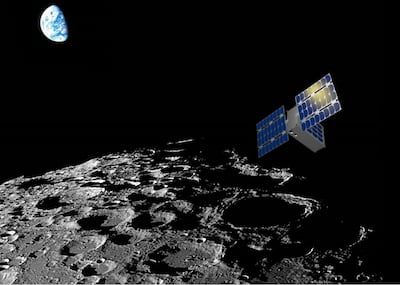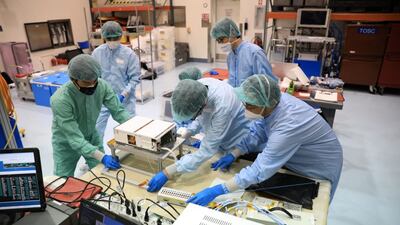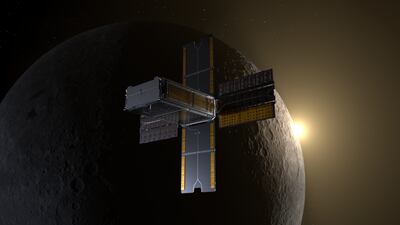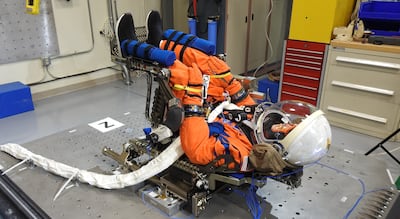Nasa’s Artemis 1 mission will conduct several science and technology experiments to help expand understanding of the Moon, including whether ice is hidden all over its surface.
The uncrewed test flight is scheduled for launch from Florida’s Kennedy Space Centre on August 29. The Space Launch System rocket will deliver the Orion spacecraft to space, and then it will fly solo to the Moon.
It is part of the space agency’s Artemis programme, which aims to build a sustainable human presence on the Moon.
The flight will carry 10 CubeSats - miniature satellites - which will support the mission's investigations. Details of a few of these were revealed during a virtual press briefing held by Nasa on Tuesday.
Jacob Bleacher, chief exploration scientist at the space agency, said these could help deepen our knowledge of lunar science and deep-space travel.
“We’re at the beginning of an exciting adventure to explore the Moon, but also to learn about our place and an evolving universe,” he said.
“Our moon serves as basically a celestial library right next door. From here, we can begin to research our history. Lunar rocks and lunar ice serve as the books of this library."
Search for lunar water ice

One of these experiments will be carried out by the LunaH-Map CubeSat, built by a team at Arizona State University.
The spacecraft will measure whether there is ice hidden in the illuminated plains of the Moon, and not just the permanently shadowed region, as was discovered previously.
Craig Hardgrove, principal investigator of the mission, said the CubeSat will pass over regions of the South Pole to see if ice extends on to sunlit parts of the surface.
“We've known for quite some time that there's water ice at the Moon's poles, but there are a lot of unanswered questions about how much there is and where exactly it is,” he said.
“Most of it is within these permanently shadowed regions of the South Pole. These are some of the coldest locations in the entire solar system, and they may have never seen sunlight.
“There's evidence that there may be ice within the sunlit plains that might be stable for millennia in those regions, but we simply don't have high enough resolution data of both poles of the Moon to really address some of these questions.
“And so that's where we came in. And to do that, we're using a tried-and-true technique called neutron spectroscopy.”
Neutron spectroscopy tools, which measure hydrated materials on planetary surfaces, have been used by Nasa previously in other missions.
Mr Hardgrove said they have an advantage because they can navigate the spacecraft into a very low altitude South Pole orbit to study the regions in depth.
Landing on the Moon with a tiny spacecraft
Apart from lunar science, Artemis 1 will also see technology demonstrations that can make future Moon landing missions easier.
Japan’s space agency Jaxa is launching its Omotenashi (Outstanding Moon Exploration Technologies demonstrated by Nano Semi-Hard Impactor) CubeSat on the flight.

Weighing only 14 kilograms, it includes an orbiter and a lander. The landing module will attempt a hard landing on the surface.
Tatsuaki Hashimoto, project manager of the mission, said that this was the world’s smallest Moon lander.
“Omotenashi itself is not a science mission, but its demonstrated technologies will enable future small surface science missions,” he said.
Altogether, the mission aims to demonstrate whether low-cost technology can be used to land and explore the lunar surface.
First deep-space biology experiment
BioSentinel, a shoebox-sixed CubeSat, will also be part of the flight.
It is the first long-duration biology experiment in deep space.
It will carry micro-organisms, in the form of yeast, so scientists can study more about the health risks in deep space posed by space radiation.
This is important for Nasa to study as it prepares to send humans to the lunar surface again, and then eventually to Mars.

“Space radiation is like a demolition derby – on the nano scale. High-energy galactic cosmic rays and bursts of solar particles permeate deep space,” Nasa said.
“These types of radiation can wreak havoc on electronics and living cells alike.”
BioSentinal will monitor vital signs of the yeast to see how they fare when exposed to deep space radiation.
Artemis 1 manikin
A suited manikin will be aboard the Orion spacecraft, fitted with sensors to provide data on what crew members may experience in flight.
This will help Nasa learn how best to protect astronauts for future crewed missions to the Moon.

“The manikin flying on Artemis I will occupy the commander’s seat inside Orion, be equipped with two radiation sensors, and wear a first-generation Orion Crew Survival System suit – a spacesuit astronauts will wear during launch, entry and other dynamic phases of their missions,” Nasa said.
The manikin’s seat will have two sensors – one under the headrest and another behind the seat – to record acceleration and vibration throughout the mission.
Engineers will use the data to make sure the suits for the first crewed flight, Artemis II, are safe.
Taking advanced images of the Moon day and night
The LunIR CubeSat will carry out flybys of the Moon and use a miniature infrared sensor – an instrument that measures the heat of an object – to collect images and data about the lunar surface and its environment.
It will gather data such as the material composition, thermal signatures, presence of water and potential landing sites.
The instrument will be able to map the Moon during the day and night and collect data at much higher temperatures than similar sensors.
This will be possible because a micro-crycooler, similar to a refrigator, is installed into it. The device can research cryogenic temperatures below -147.7°C.











